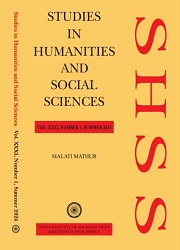The Structure of Inference (Anumana) in the Atmatattvaviveka
Keywords:
Atmatattvaviveka, Ksnabhangavada, Momentariness, Purvapaksha, Udayanacarya JnanasrimitraAbstract
The Atmatattvaviveka (hereafter ATV) is authored by Udayanacarya, the Nyaya philosopher of 10th-11th century AD, to meet the challenges posed by the Buddhist logicians of his time particularly Jnanasrimitra (c. 980-1030 AD) in order to establish the existence of self (atman). The method adopted in the text is to reconstruct four theories that seem to be an imminent threat to the Nyaya conception of the self and refute them. The theories in question are the doctrine of impermanence (kasnabhangavada), the rejection of external objects (bahyarthabhanga), the rejection of the difference between substance and properties (gunagunibhedabhanya), and noncognition (anupalambha). The major part of ATV is devoted to the reformulation and refutation of these abovementioned theories. First of all, Udayana targets to reject the Buddhist doctrine of momentariness since it questions the possibility of the existence of anything unchanging, then he moves to examine the proposal of the unreality of the external world since the acceptance of mindindependent objects involves the possibility of denying the self as distinct from knowledge. The third theory is targeted towards the acceptance of indifference between the properties and the substance since it implies the denial of the self as different from its properties. Towards the end, he examines the suggestion coming from the nonapprehension of anything eternal which is also indicative of the non-existence of the eternal self and then briefly advances the Nyaya conception of atman.
Udayana follows the method of reductio ad absurdum which seeks to demonstrate absurdity in a position to declare it inconsistent. Generally, Indian logicians present an opponent’s viewpoint (purvapaksha) in order to refute it (khandana) before proposing their own viewpoint (siddhanta/mandana). The main objective of the present article is to see the structure of reasoning adopted by Udayana in his ATV. The exploration intends to utilize the technique of the Venn diagram, wherever possible, for a diagrammatic representation of the pattern of argumentation besides using some nuances of symbolic logic. The article is confined to the refutation of the theory of momentariness in the Buddhist philosophy. The conjecture is that Udayana ends up refuting his own formulation of the opponents’ position than theirs in letter and spirit, but in doing so, he has contributed to the logical development of various dimensions of at least one version of the doctrine which any Buddhist logician would have designed it.


